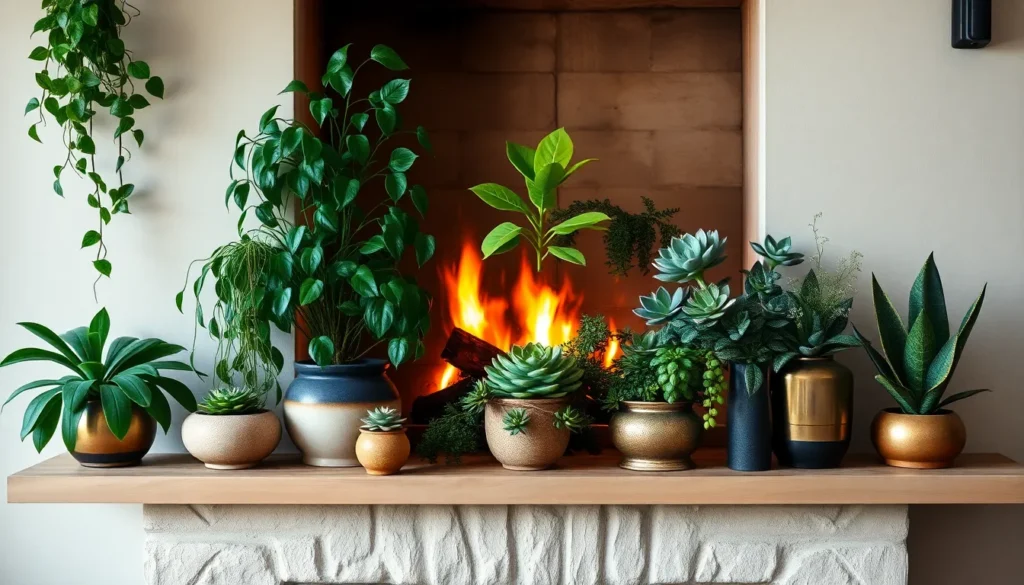Transform your fireplace mantle from ordinary to extraordinary with the perfect plant selections. We’ve discovered that adding greenery to this prominent focal point creates an instant style upgrade that captures attention and breathes life into any living space.
Plants on fireplace mantles aren’t just decorative elements – they’re strategic design choices that soften hard architectural lines while adding natural texture and color. Whether you’re working with a traditional brick surround or a sleek modern design, the right plants can complement your existing décor and create visual balance.
We’ll guide you through selecting heat-tolerant varieties that thrive in mantle conditions, arranging them for maximum visual impact, and maintaining their health in this unique environment. From cascading pothos to sculptural succulents, discover how to create a stunning mantle display that becomes the centerpiece of your room.
Choose Heat-Tolerant Plants That Thrive Above Your Fireplace Mantle
Selecting plants that can withstand the heat radiating from your fireplace requires careful consideration of their natural tolerance levels. We’ve identified three exceptional plant categories that not only survive but flourish in these challenging conditions.
Succulents and Cacti for Low Maintenance Appeal
Succulents offer the perfect solution for fireplace mantle displays since they naturally store water in their thick leaves and stems. These drought resistant plants thrive in warm environments and require watering only once every 2-3 weeks during active fireplace seasons.
Echeveria rosettes create stunning geometric patterns with their perfectly arranged leaves, while jade plants develop thick woody stems that add sculptural interest to your mantle arrangement. Barrel cacti and prickly pear varieties bring unique textures and occasional colorful blooms that complement traditional fireplace surroundings.
Most succulents prefer temperatures between 65-80°F, making them ideal candidates for mantle placement where heat fluctuations occur regularly. Their compact root systems adapt well to shallow decorative containers, and their slow growth rate means minimal repotting requirements throughout the year.
Air Plants That Require Minimal Soil and Water
Air plants eliminate the mess and maintenance concerns typically associated with fireplace mantle greenery since they absorb moisture and nutrients directly from the atmosphere. Tillandsia ionantha produces vibrant red and purple coloration when exposed to bright light and warmth, creating natural seasonal displays above your fireplace.
Spanish moss varieties cascade elegantly from decorative holders, softening harsh mantle edges while requiring only weekly misting with distilled water. Tillandsia xerographica forms impressive silver rosettes that can reach 12 inches in diameter, serving as stunning focal points for larger mantle spaces.
These epiphytic plants actually benefit from the gentle air circulation created by fireplace heat, which prevents moisture buildup and reduces the risk of rot. We recommend mounting air plants on driftwood pieces or displaying them in glass orbs for easy repositioning during cleaning.
Snake Plants for Vertical Interest and Durability
Snake plants deliver exceptional vertical drama with their sword shaped leaves that can reach heights of 2-4 feet, creating striking silhouettes against fireplace backgrounds. Sansevieria trifasciata varieties feature bold yellow margins and dark green centers that complement both traditional and modern mantle designs.
Sansevieria cylindrica produces thick cylindrical leaves arranged in fan patterns, offering unique architectural interest that pairs beautifully with minimalist fireplace surrounds. These plants tolerate neglect exceptionally well, surviving on monthly watering schedules even during peak heating seasons.
Their natural air purifying qualities remove toxins like formaldehyde and benzene from indoor environments, making them functional additions to your living space. Snake plants also produce small white flowers on tall stalks during optimal growing conditions, adding unexpected seasonal interest to your mantle display.
Position Plants Strategically to Avoid Heat Damage
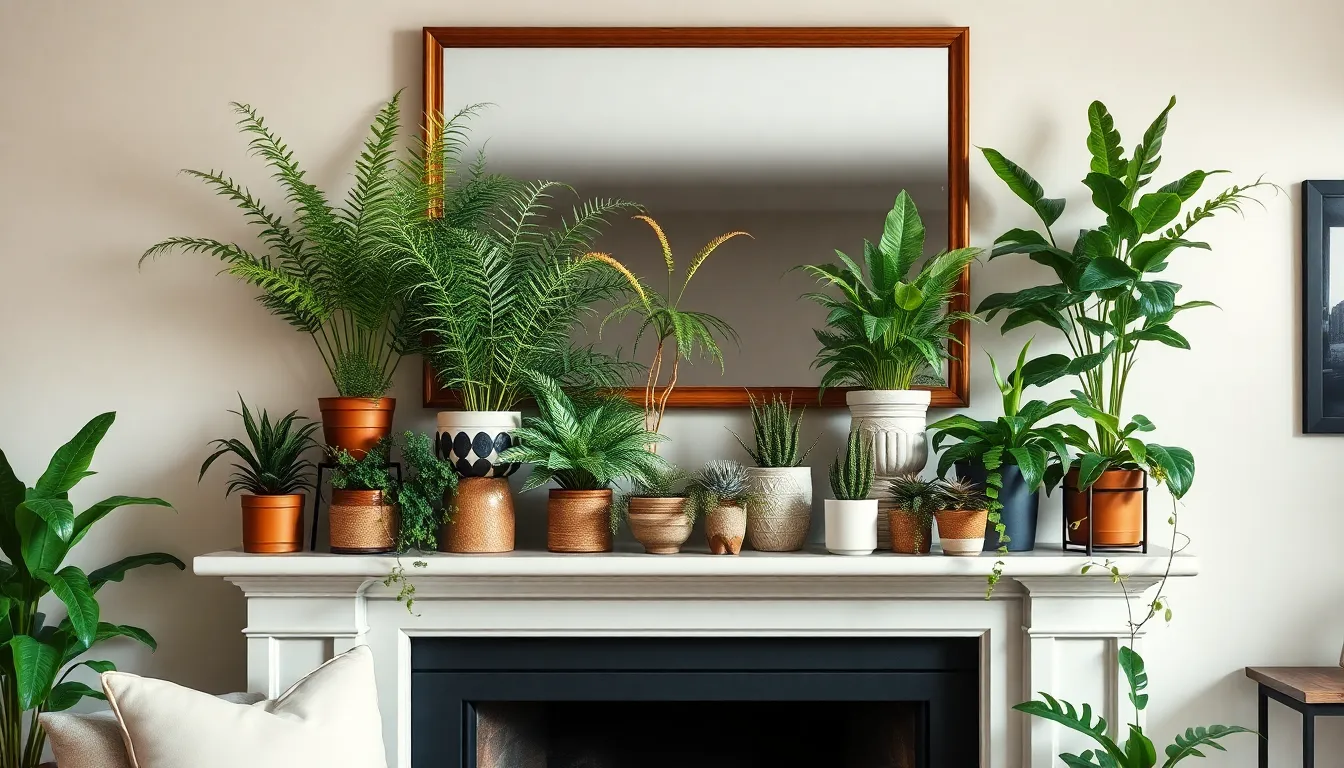
Smart placement protects your mantle plants from heat stress while maintaining their decorative appeal. We’ll ensure your greenery thrives by implementing proven positioning strategies.
Create Distance Between Plants and Heat Sources
Heat from fireplaces can quickly dry out and damage plants, making proper spacing essential for plant health. We recommend testing potential plant locations by holding your hand near the spot – if you feel heat, it’s too close for plants. Maintaining adequate clearance between the mantle edge and plant containers prevents direct heat exposure that causes leaf burn and root damage.
Avoid placing plants directly on the mantle surface if it sits directly above the firebox, as rising heat naturally travels upward. Consider the fireplace’s heat radius when arranging your display, positioning larger plants toward the outer edges of the mantle where temperatures remain cooler. Strategic spacing also allows for better air circulation around each plant, reducing the risk of heat buildup.
Use Heat-Resistant Plant Stands and Containers
Elevating plants off the mantle surface creates a protective barrier against heat transfer to roots and soil. We suggest using stands made from ceramic, stone, or metal materials that resist heat absorption and provide insulation. These materials help moderate temperature fluctuations while adding visual interest to your plant display.
Heat resistant containers prevent soil from overheating and protect root systems from thermal stress. Consider double-potting techniques where you place decorative planters inside heat resistant outer containers for extra protection. Raised platforms also improve air circulation beneath plant containers, creating a cooling effect that benefits overall plant health.
Monitor Temperature Fluctuations Throughout the Seasons
Fireplace usage creates seasonal temperature variations that require adjusting plant care routines accordingly. We track how heating seasons affect our mantle environment, noting that cold winters with regular fireplace use and warmer summers create different challenges for plant health. Temperature monitoring helps identify when to relocate plants temporarily during peak heating periods.
Humidity levels fluctuate significantly with fireplace operation, often dropping to levels that stress most houseplants. Creating beneficial microclimates by grouping plants together increases local humidity through transpiration. Installing humidifiers near your mantle display or using water-filled trays can counteract the drying effects of fireplace heat, maintaining optimal moisture levels for your plants.
Select Appropriate Containers That Complement Your Mantle Design
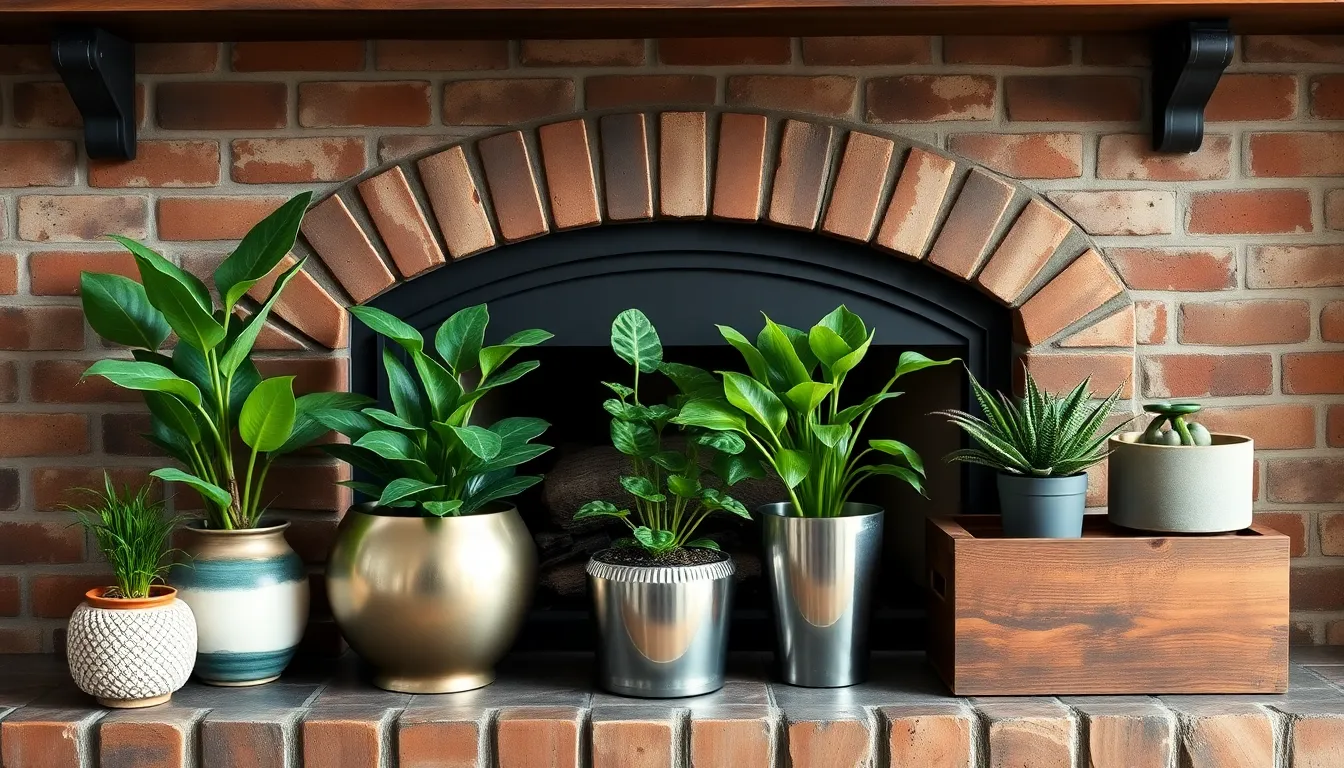
After positioning your heat-tolerant plants strategically, we need to focus on choosing containers that enhance both your plants and your mantle’s overall aesthetic. The right planters create visual harmony while protecting your greenery from temperature fluctuations.
Ceramic and Stone Planters for Classic Appeal
Ceramic and stone planters deliver timeless elegance that perfectly complements traditional mantle designs. These solid containers feature earthy textures that enhance natural greenery while maintaining a sophisticated atmosphere in your living space.
Stone planters offer exceptional durability and natural insulation properties that protect plant roots from temperature changes. We recommend choosing neutral tones like cream, gray, or soft brown to create a cohesive look with classic brick or marble mantles.
Glazed ceramic options provide additional moisture retention while adding subtle color variations to your display. Terra cotta containers work especially well with succulents and cacti, as their porous nature prevents root rot in warm mantle environments.
Modern Metal Containers for Contemporary Spaces
Modern metal containers create clean, minimalistic aesthetics that complement contemporary mantle designs perfectly. Sleek finishes like brushed steel, copper, or matte black add industrial chic elements while maintaining the sophisticated appeal of your fireplace area.
Brushed steel planters reflect light beautifully and pair exceptionally well with modern gas fireplaces or sleek stone surrounds. These lightweight options make rearranging your plant display effortless when seasonal decorating calls for changes.
Copper containers develop attractive patina over time, adding character while maintaining their modern appeal. We’ve found that matte black metal planters create striking contrast against light-colored mantles and showcase trailing plants like pothos dramatically.
Vintage and Rustic Options for Traditional Decor
Vintage and rustic containers bring warmth and character to traditional mantle displays through their weathered textures and lived-in appeal. Aged metal buckets, distressed wooden boxes, and weathered ceramic pots complement exposed brick mantles and create cozy, inviting atmospheres.
Galvanized metal buckets offer authentic farmhouse charm while providing excellent drainage for your mantle plants. These containers work particularly well with trailing ivy or snake plants, creating casual elegance that feels naturally integrated with rustic decor.
Distressed wooden boxes add organic warmth that pairs beautifully with stone or brick fireplace surrounds. We recommend sealing wooden containers with plant-safe sealers to prevent moisture damage while maintaining their rustic appearance.
Weathered ceramic pots in earth tones create perfect harmony with traditional mantle materials like natural stone or aged wood. These containers develop beautiful patina over time, improving the vintage appeal of your plant display.
Arrange Plants in Balanced Compositions for Visual Impact
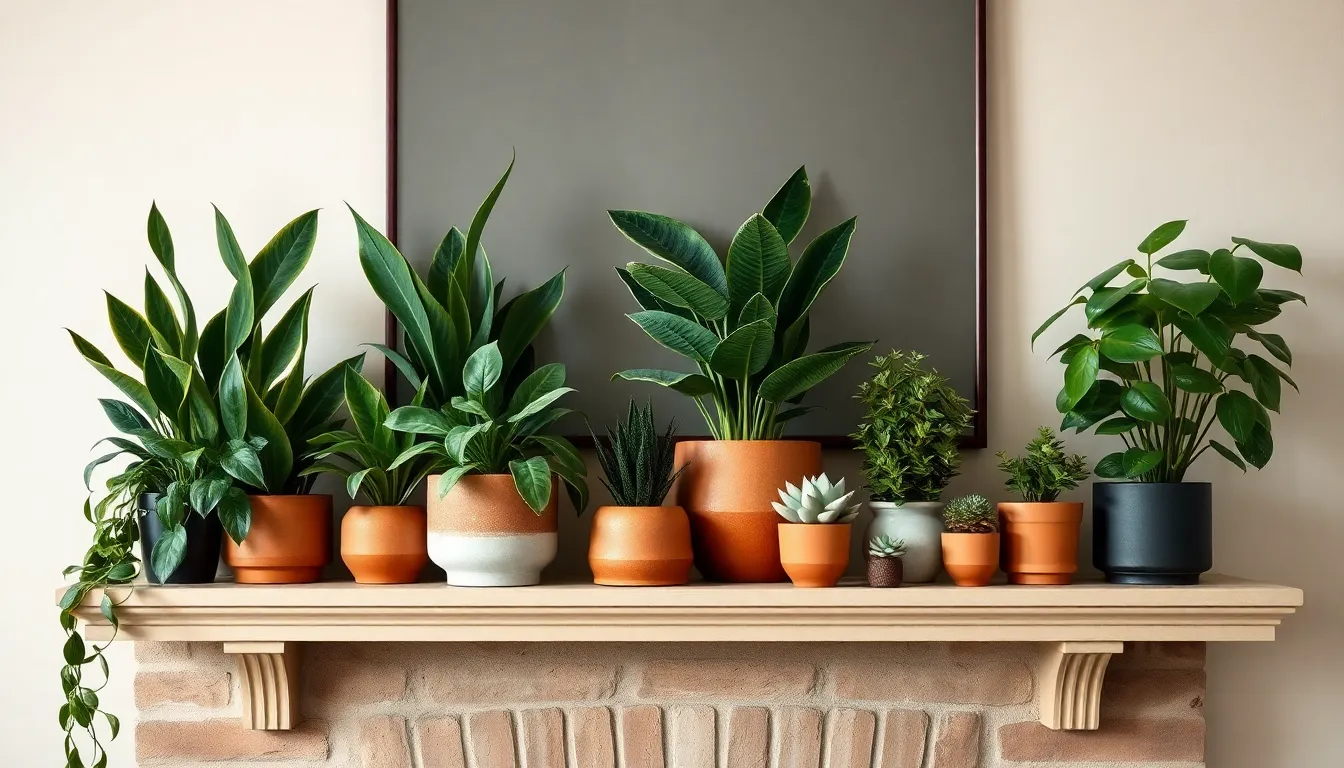
Creating a stunning mantle display requires thoughtful plant arrangement that considers size, shape, and volume distribution. We’ll guide you through proven techniques that transform your fireplace mantle into a captivating focal point.
Create Height Variation with Different Sized Plants
Layering plants at different heights adds dimensional depth that prevents flat, monotonous displays. Place taller plants like snake plants or tall succulents at the back or center of your mantle to establish vertical anchor points. Position medium-sized plants such as jade plants or echeveria clusters in the middle ground to bridge the visual gap. Arrange shorter air plants or small succulent arrangements at the front edges where they won’t be overshadowed by larger specimens.
This strategic layering creates a cascading effect that draws the eye naturally across the entire display. Consider using plant stands or risers to elevate certain plants and achieve optimal height variation without overcrowding your mantle space.
Use the Rule of Odds for Pleasing Arrangements
Odd-numbered groupings create more visually appealing and organic arrangements than even numbers. Start with three plants of varying heights and textures to establish your foundation grouping. Expand to five or seven plants for longer mantles, maintaining the odd number principle for each distinct cluster you create.
Group three different succulent varieties together, such as an echeveria rosette paired with a trailing pothos and an upright jade plant. This combination offers varied shapes while maintaining visual cohesion. Odd arrangements naturally guide the eye in a flowing pattern that feels balanced and intentional rather than rigid or forced.
Balance Plant Colors with Your Room’s Color Scheme
Coordinate your plant selection with existing room colors to create harmonious visual flow throughout your space. Choose vibrant green foliage or colorful blooms for neutral rooms where plants can serve as refreshing accent pieces. Select plants with subtler tones or variegated leaves for rooms with bold color schemes to avoid overwhelming the existing palette.
Match your containers to your room’s decor style and color temperature for unified design impact. Ceramic planters in earth tones complement warm color schemes, while sleek metal containers work beautifully with cool-toned spaces. Consider how the natural greens of your chosen plants will interact with wall colors, furniture finishes, and decorative accessories to ensure your mantle arrangement enhances rather than competes with your room’s overall aesthetic.
Maintain Proper Lighting Conditions for Mantle Plants
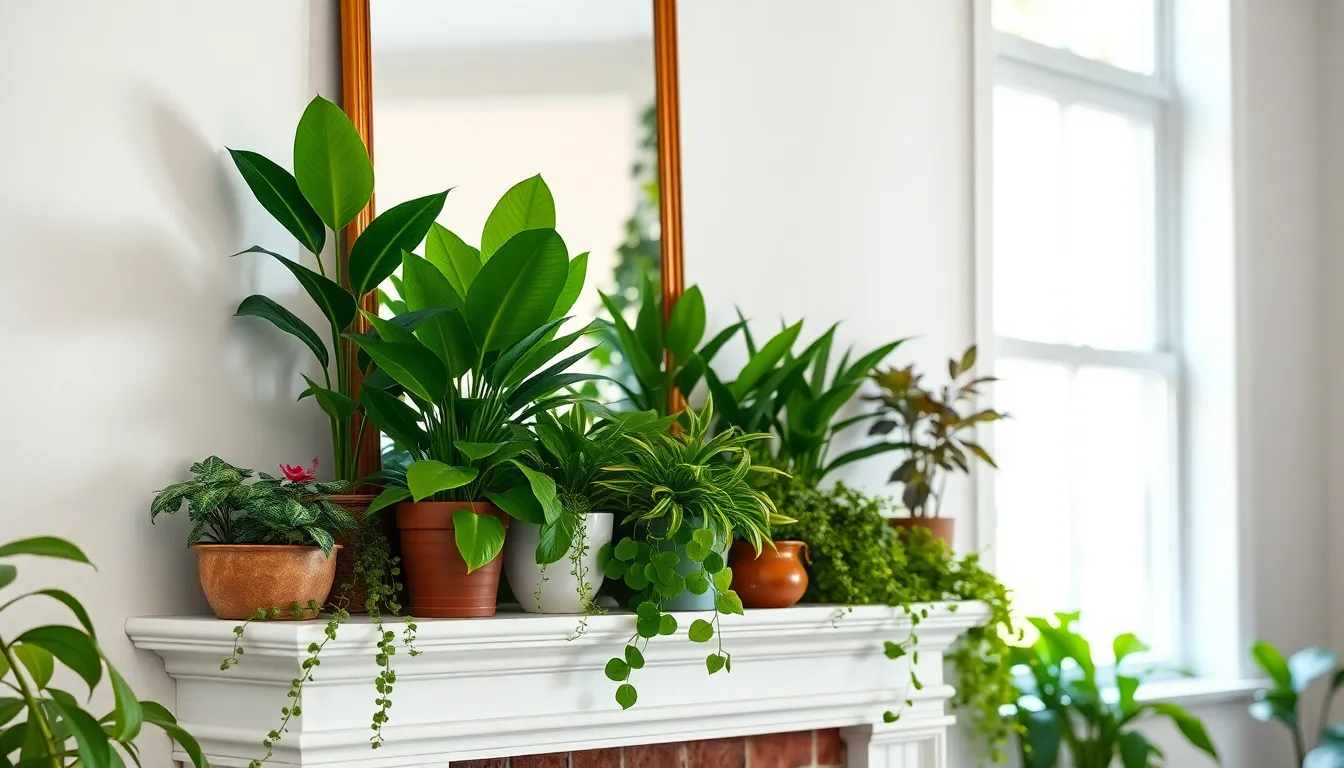
Lighting serves as the foundation for healthy plant growth on fireplace mantles. We’ll explore three essential lighting strategies that ensure your mantle plants receive adequate illumination for optimal health and vibrant appearance.
Supplement Natural Light with Grow Lights
Grow lights become essential when natural sunlight proves insufficient for mantle plants. Full-spectrum LED grow lights simulate sunlight and provide the necessary intensity for photosynthesis, especially during shorter winter days or in rooms lacking direct window access. We recommend running these lights for 6 to 12 hours daily to promote healthy growth and maintain vibrant foliage.
Strategic placement of grow lights above or beside your mantle display creates consistent illumination without disrupting your decor. Modern LED options generate minimal heat, making them safe for use near heat-sensitive plants on mantles. Consider timer-controlled systems that automatically adjust lighting duration based on seasonal needs.
Position Plants Near Windows When Possible
Positioning mantle plants near windows maximizes available natural light and reduces dependence on artificial illumination. South-facing and east-facing windows generally provide the brightest light conditions throughout the day. We suggest placing your mantle within 3 to 6 feet of these optimal window orientations when your room layout allows.
Filtered or indirect light works best for most indoor plants, as harsh direct sunlight can scorch delicate leaves. Sheer curtains or blinds help diffuse intense afternoon sun while maintaining adequate brightness levels. Consider the seasonal changes in light intensity and adjust plant positions accordingly throughout the year.
Rotate Plants Regularly for Even Growth
Rotating mantle plants prevents uneven growth patterns and maintains attractive, balanced displays. We recommend turning each plant a quarter turn every week to ensure all sides receive equal light exposure. This simple practice prevents plants from leaning toward light sources and promotes uniform foliage development.
Regular rotation becomes especially important for plants positioned at the edges of your mantle display, where light distribution may vary significantly. Mark plant containers with discreet dots or use a rotation schedule to track which direction each plant faces. Consistent rotation schedules help maintain the sculptural quality of your mantle arrangement while supporting healthy plant development.
Water Plants Carefully to Prevent Mantle Damage
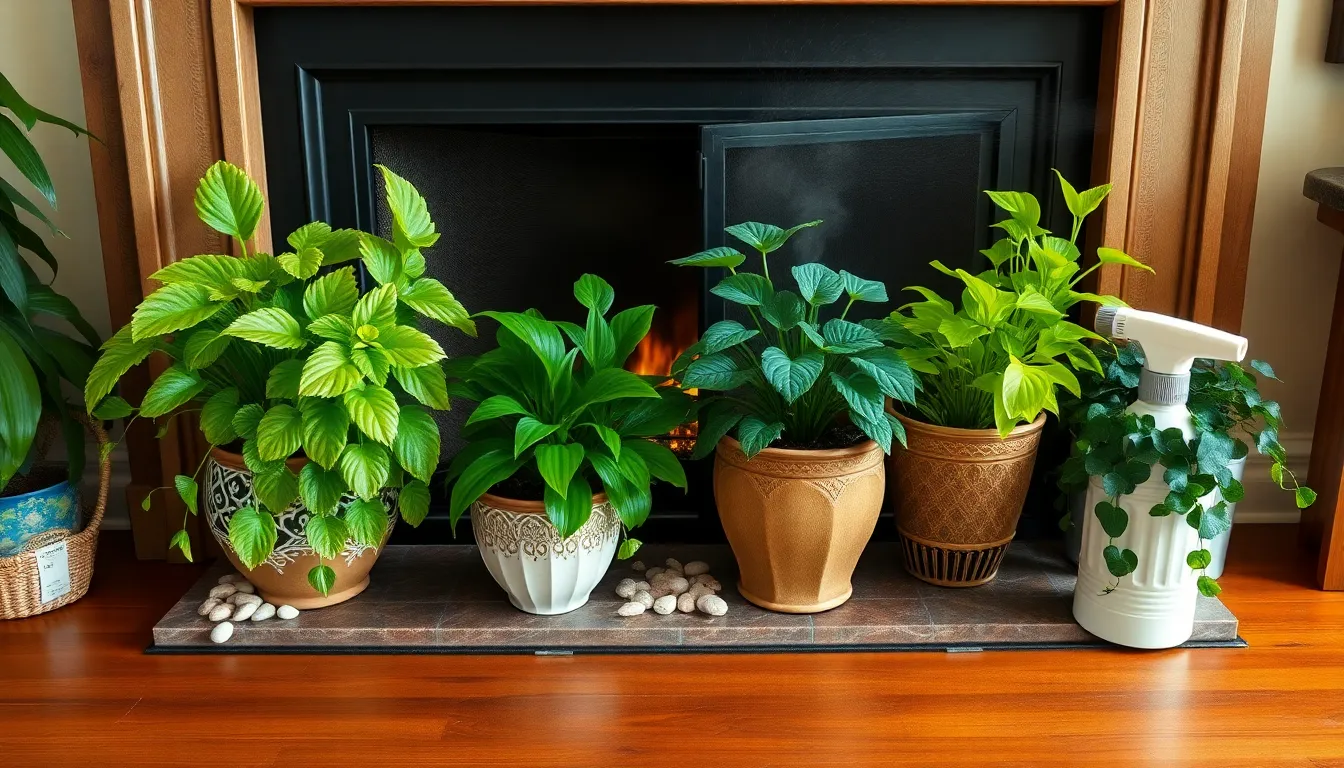
Proper watering techniques protect both our plants and our precious mantle surfaces from costly damage. We’ll explore essential strategies to maintain healthy greenery while safeguarding wood and stone materials.
Use Drainage Trays to Protect Wood and Stone Surfaces
Drainage trays serve as our first line of defense against water damage on fireplace mantles. We recommend placing pebble trays or waterproof saucers under every pot to catch excess water before it reaches the mantle surface. Wood mantles are particularly vulnerable to water stains and warping from standing moisture.
Pebble trays offer dual benefits for plants like Ceylon golden varieties that thrive in filtered light conditions. These trays prevent water damage while increasing humidity levels around our plants. Stone surfaces also benefit from this protection, as repeated water exposure can cause discoloration and mineral buildup over time.
Establish a Consistent Watering Schedule
Consistent watering routines keep our mantle plants healthy while preventing moisture-related damage. We should water philodendrons and ivies when the top inch of soil feels dry to the touch. Red aglaonema varieties can tolerate longer periods between watering, often going one to two weeks without moisture.
Regular scheduling prevents both overwatering and underwatering issues that commonly affect mantle displays. Norfolk Island pine plants are particularly susceptible to root rot when left in standing water, making consistent but moderate watering essential. We can align our watering routine with the exact needs of each plant species for optimal results.
Monitor Soil Moisture Levels More Frequently
Fireplace mantles create unique growing conditions that require more frequent soil monitoring than typical houseplant locations. Heat sources near mantles cause soil to dry out faster than usual, especially during colder months when indoor heating systems operate continuously. We need to check soil moisture levels at least twice weekly to maintain proper hydration.
Misting plants like ivy helps maintain humidity and leaf health when they’re positioned near dry heat sources. Regular monitoring prevents both dehydration stress and overwatering problems that can damage our mantle surfaces. We should feel the soil at different depths to ensure moisture levels remain consistent throughout the root zone.
Style Your Mantle with Seasonal Plant Rotations
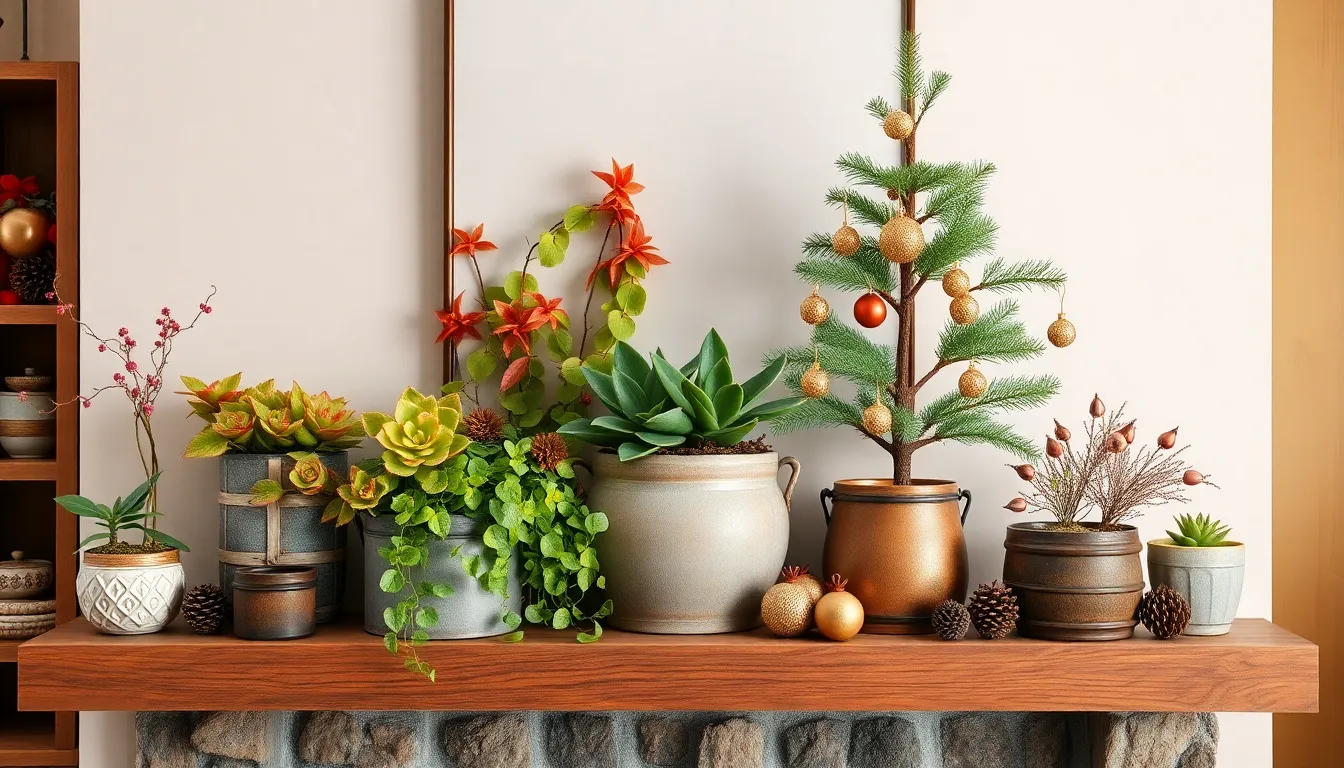
Seasonal plant rotations transform your fireplace mantle into a ever-changing display that reflects the changing seasons. We’ll show you how to create stunning arrangements that celebrate each time of year with strategic plant selections and styling techniques.
Spring and Summer Plant Displays
Vibrant succulents in clean white pots create a modern, fresh look perfect for warmer months. We recommend colorful varieties, haworthia with distinctive stripy patterns, and snake plants to add sculptural texture without overwhelming your mantle space.
Norfolk Island pines thrive in bright light conditions and work beautifully as statement pieces during spring and summer. These plants can be dressed up with colorful containers or lightweight decorations to enhance their natural appeal.
Trailing plants like pothos and ivy provide lush green cascades that frame your fireplace elegantly. During warmer seasons, these plants flourish in medium to bright indirect light while adding natural softness to your mantle arrangement.
Mix tall, upright plants with smaller succulents to create balanced height variations that draw the eye across your entire display. This combination ensures visual interest while maintaining the clean, fresh aesthetic perfect for spring and summer styling.
Fall and Winter Greenery Options
Ivy becomes a classic autumn choice when displayed in groups featuring varying leaf shapes and textures. We suggest using rustic containers like burlap-wrapped pots or burnished copper planters to enhance the seasonal appeal.
Drier indoor air from heating systems requires regular misting of trailing plants to maintain proper humidity levels. This practice prevents leaf drying and keeps your greenery looking vibrant throughout the colder months.
Evergreens such as Norfolk Island pine provide consistent winter color and can be styled with seasonal ornaments. These plants maintain their beauty while offering the flexibility to incorporate holiday decorations as desired.
ZZ plants and nerve plants work exceptionally well during fall and winter months due to their tolerance for lower humidity conditions. Their sturdy nature makes them ideal for maintaining consistent mantle displays when heating systems create challenging growing conditions.
Holiday-Themed Plant Arrangements
Miniature Christmas trees using Norfolk Island pines can be decorated with lightweight holiday ornaments like plastic berries or small baubles. This approach celebrates the season without weighing down delicate branches or compromising plant health.
Red, gold, and green decorations at pot bases create festive presentations that complement your plants’ natural beauty. We recommend coordinating these colors with your existing holiday decor for a cohesive look throughout your living space.
Seasonal container rotations offer an easy way to refresh your mantle’s holiday appearance without replacing plants entirely. Simply switch out pot colors and materials to match different celebrations while maintaining your established plant arrangements.
Train trailing vines to cascade safely downward during holiday displays, ensuring they don’t create fire hazards near your fireplace. This technique adds dramatic vertical interest while maintaining safety standards for your seasonal arrangements.
Conclusion
We’ve shown you how to transform your fireplace mantle into a stunning botanical showcase that enhances your home’s ambiance year-round. With the right heat-tolerant plants proper containers and thoughtful seasonal rotations you’ll create a ever-changing focal point that brings life to your living space.
Remember that success lies in understanding your mantle’s unique conditions and choosing plants that thrive in those circumstances. Whether you prefer the sculptural beauty of succulents the trailing elegance of pothos or the seasonal charm of evergreens there’s a perfect combination waiting to complement your decor.
Your mantle deserves more than dust collectors – it deserves the vibrant natural beauty that only plants can provide.
Frequently Asked Questions
What are the best heat-tolerant plants for fireplace mantles?
The top heat-tolerant plants for mantles include succulents and cacti (like jade plants and echeveria), air plants (tillandsia species), and snake plants. These varieties can withstand the warmth generated by fireplaces while requiring minimal maintenance. Trailing plants like pothos and ivy also work well when positioned away from direct heat sources.
How do I protect my mantle plants from heat damage?
Position plants at least 12-18 inches away from the fireplace opening and use heat-resistant containers made of ceramic, stone, or metal. Monitor plant placement during active fire use and consider moving them temporarily. Choose naturally heat-tolerant species and ensure proper ventilation around the mantle area.
What containers work best for mantle plant displays?
Ceramic, stone, and metal containers are ideal for mantle displays as they’re heat-resistant and complement various decor styles. Choose containers that match your mantle’s aesthetic – rustic stone for farmhouse styles, sleek ceramic for modern looks, or vintage metal for industrial themes. Ensure proper drainage to prevent water damage.
How should I arrange plants on my fireplace mantle?
Use the “Rule of Odds” by grouping plants in sets of three or five for visual appeal. Vary plant heights and sizes to create depth and interest. Place taller plants toward the back and shorter ones in front. Balance trailing plants with upright varieties for dynamic composition.
How often should I water mantle plants?
Water mantle plants less frequently than typical houseplants due to increased heat and faster soil drying. Check soil moisture weekly and water when the top inch feels dry. Use saucers to protect the mantle surface and avoid overwatering, which can cause root rot in heat-stressed plants.
Can I change my mantle plants seasonally?
Yes, seasonal plant rotations create dynamic displays. Use vibrant succulents and trailing plants for spring/summer, and switch to evergreens, ivy, and ZZ plants for fall/winter. This approach keeps your mantle fresh while ensuring plants get appropriate care during different seasons and heating cycles.
What lighting conditions do mantle plants need?
Most mantle plants thrive in bright, indirect light typically found near windows. If your mantle lacks natural light, consider low-light tolerant plants like snake plants or ZZ plants. Avoid placing plants in direct sunlight combined with fireplace heat, as this can cause stress and damage.
How do I maintain humidity for mantle plants in winter?
During winter heating seasons, increase humidity around mantle plants by using pebble trays filled with water, grouping plants together, or using a small humidifier nearby. This prevents leaves from drying out due to low indoor humidity levels common during colder months.

